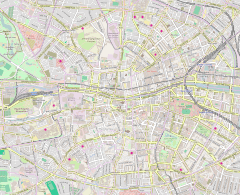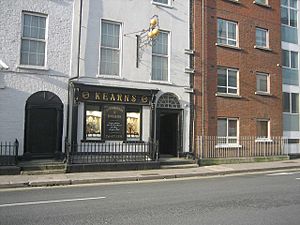Queen Street, Dublin facts for kids
| Sráid na Banríona (Irish) | |

northern end of Queen Street
|
|
| Part of | Smithfield |
|---|---|
| Namesake | Elizabeth I or Catherine of Braganza |
| Type | Street |
| Postal code | D07 |
| Coordinates | 53°20′53″N 6°16′48″W / 53.348096°N 6.279912°W |
| north end | North King Street |
| south end | Arran Quay |
Queen Street is a historic street in Dublin, Ireland. It runs from North King Street in the north all the way down to Arran Quay by the River Liffey. This street is part of the lively Smithfield area.
Where is Queen Street?
Queen Street starts at Arran Quay and Mellows Bridge in the south. It stretches north to North King Street. Along its path, it crosses several other old streets. These include Hendrick Street and Benburb Street. At its northern end, Queen Street joins with George's Lane. This part of the street was made wider in 2002.
A Look Back in Time
Queen Street was first created in 1687. People believe it was named after Elizabeth I, who was Queen of England from 1558 to 1603. However, some also think it might have been named for Catherine of Braganza. She was queen when she was married to King Charles II from 1662 to 1685.
This street is in an old part of Dublin once called Oxmantown. It is very close to what used to be a large common green area. The idea for Queen Street as a main road from this common area was first planned in 1664.
In 1671, a special school called the Blue Coat Boys Hospital was built on the east side of Queen Street. This school is now known as The King's Hospital. Later, in 1782, the land was divided up for houses. These houses were finished by 1800. They were large, fancy homes typical of the Georgian period. In the 20th century, these old houses were replaced with new public housing.
Buildings and Design
Even today, a few interesting old buildings can still be seen on Queen Street. Most of these are found where Queen Street meets other roads. For example, 79 Queen Street was once a commercial building. It has a stone showing the year 1770. However, the building we see today was built around 1860. It has the classic look of Victorian buildings.
There are also two old Georgian houses, numbers 69 and 70. These houses were built around 1790. They are now connected and used as a pawnbroker's shop. A pawnbroker is a business that lends money in exchange for valuable items.
In the 1990s, new apartment buildings were constructed on Queen Street. These were built where older houses had been torn down to make the road wider. A designer named Shay Cleary created these new buildings. Some local politicians, like Tony Gregory, wanted houses to be built instead of apartments. However, the apartment plan went ahead. It was finished in 2003. This project also included updating existing public housing in the area. By the early 2000s, many of the shops near the river were used as furniture showrooms.




